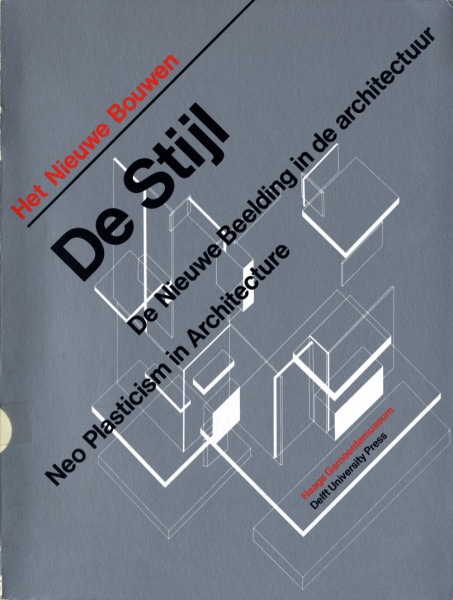Ulrich Conrads (ed.): Programs and Manifestoes on 20th-Century Architecture (1964/1970)
Filed under book | Tags: · architecture, art, avant-garde, bauhaus, city, constructivism, functionalism, manifesto, modernism, neoplasticism, utopia

“The present volume offers eloquent testimony that many of the master builders of this century have held passionate convictions regarding the philosophic and social basis of their art. Nearly every important development in the modern architectural movement began with the proclamation of these convictions in the form of a program or manifesto. The most influential of these are collected here in chronological order from 1903 to 1963. Taken together, they constitute a subjective history of modern architecture; compared with one another, their great diversity of style reveals in many cases the basic differences of attitude and temperament that produced a corresponding divergence in architectural style.
In point of view, the book covers the aesthetic spectrum from right to left; from programs that rigidly generate designs down to the smallest detail to revolutionary manifestoes that call for anarchy in building form and town plan. The documents, placed in context by the editor, are also international in their range: among them are the seminal and prophetic statements of Henry van de Velde, Adolf Loos, and Bruno Taut from the early years of the century; Frank Lloyd Wright’s 1910 annunciation of Organic Architecture; Gropius’s original program for the Bauhaus, founded in Weimar in 1919; “Towards a New Architecture, Guiding Principles” by Le Corbusier; the formulation by Naum Gabo and Antoine Pevsner of the basic principles of Constructivism; and articles by R. Buckminster Fuller on universal architecture and the architect as world planner. Other pronouncements, some in flamboyant style, including those of Erich Mendelsohn, Hannes Meyer, Theo van Doesburg, Oskar Schlemmer, Ludwig Mies van der Rohe, El Lissitzky, and Louis I. Kahn. There are also a number of collective or group statements, issued in the name of movements such as CIAM, De Stijl, ABC, the Situationists, and GEAM.
Since the dramatic effectiveness of the manifesto form is usually heightened by brevity and conciseness, it has been possible to reproduce most of the documents in their entirety; only a few have been excerpted.”
First published as Programme und Manifeste zur Architektur des 20. Jahrhunderts by Verlag Ullstein, Frankfurt/M and Berlin, 1964.
Translated by Michael Bullock
Publisher MIT Press, 1970
ISBN 0262530309, 9780262530309
192 pages
via carlao126
PDF (4 MB)
See also Charles Jencks, Karl Kropf (eds.), Theories and Manifestoes of Contemporary Architecture, 1997.
Comment (0)Het Nieuwe Bouwen: De Stijl: Neo Plasticism in Architecture (1983) [English/Dutch]
Filed under book, catalogue | Tags: · architecture, art, art history, art theory, de stijl, functionalism, history of architecture, neoplasticism

“In 1975, as a result of intensive teamwork, the Netherlands Museum of Modern Architecture, the Stedelijk Museum in Amsterdam, the Gemeente Museum in The Hague and the Rijksmuseum Kröller-Müller at Otterlo presented a variegated picture of Dutch architecture from 1890 to 1930 in four exhibitions. The interest in them was so great that it was decided almost at once to take up a similar project again after a few years, this time on the subject of ‘Nieuwe Bouwen’ and the Netherlands 1920-1960. That undertaking has now resulted in five exhibitions (a new participant being the Boymans-van Beuningen Museum in Rotterdam), each of which shows a different aspect of ‘Nieuwe Bouwen’, from its prior history to its latter days. ‘Nieuwe Bouwen’ or Functionalism was a worldwide phenomenon which began to appear after the First World War. The realization that a new society was imminent was felt by many to demand radical new solutions to social, economic and cultural problems. In the Netherlands the first contribution to the stating of those problems was made by the artists and architects who had united in the De Stijl movement.” (from the Foreword)
With texts by Theo van Doesburg, Henk Engel, Pieternel Fortuyn, Jan de Heer, Cees Boekraad, Yve-Alain Bois, Umberto Barbieri and Herbert Henkels.
Het Nieuwe Bouwen: De Stijl: De Nieuwe Beelding in de architectuur. Neo-Plasticism in Architecture
Edited by Cees Boekraad, Flip Bool, Herbert Henkels
With an Introduction by Cees Boekraad
Publisher Delft University Press, Delft, and Haags Gemeentemuseum, Den Haag, 1983
ISBN 9062751040
179 pages
via TU Delft
PDF (327 MB)
Comment (0)
